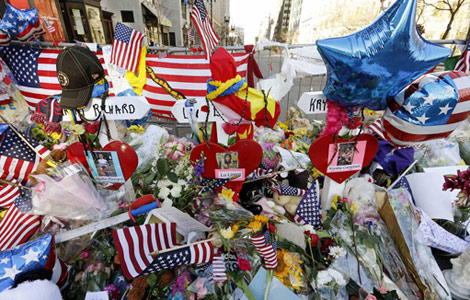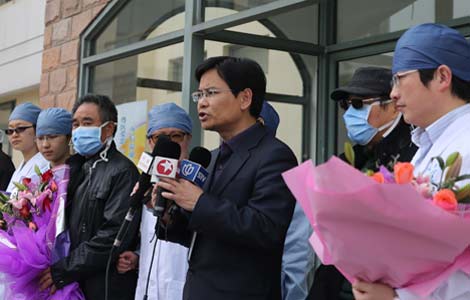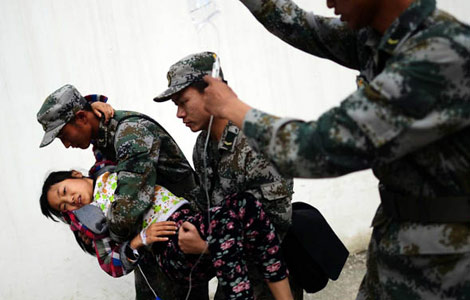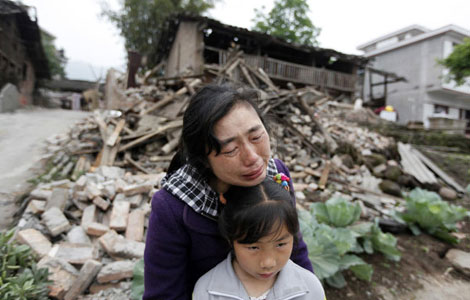Full Text of Human Rights Record of the United States in 2012
Updated: 2013-04-21 13:49
(Xinhua)
|
|||||||||
III. On Economic and Social Rights
To date, the US government has not approved the International Covenant on Economic, Social and Cultural Rights, which was already ratified by 160 countries. Many American citizens could not enjoy the internationally-recognized economic and social rights.
Unemployment in the US has long been high. A huge number of Americans newly joined the unemployed population in recent years. Figures released by the US Department of Labor on May 4, 2012 showed that in April 2012 the unemployment rate was 8.1 percent, with 12.5 million people unemployed. Citing a report, the Huffington Post website in a story dated December 3, 2012 said nearly 6.5 million US teens and young adults are neither in school nor working, and the employment rate for teens between the ages of 16 and 19 has fallen 42 percent over the last decade. The Los Angeles Times in a report published on April 27, 2012 said the unemployment rate for veterans of Afghanistan and Iraq is 10.3 percent, and for veterans aged 24 and under, the rate is 29.1 percent. It is also hard for college graduates to find jobs. The Associated Press reported on April 22, 2012 that 53.6 percent of bachelor' s degree-holders under the age of 25 in America were jobless or underemployed in 2011. Of the nearly 20 million people employed by the American food industry, just 40 percent are earning enough to put them over the local poverty line (www.huffingtonpost.com, June 6, 2012).
Poverty in the US has increasingly worsened since the economic crisis in 2008. America' s poverty rate in 2011 was 15 percent, with 46.2 million people in poverty, according to the US Census Bureau data released on September 12, 2012. Almost 18 million American homes struggled to find enough to eat in 2011, including 6.8 million households that worried about having enough money to buy food several months out of the year (www.ers.usda.gov, September 5, 2012). A report carried by the Huffington Post on October 30, 2012 indicated that the US has a staggering 22 percent of its children living in poverty. The US is one of those that have the highest child poverty rates of all developed nations.
The gap between the rich and poor is growing in the US over the years. The US has the fourth worst income inequality compared to other developed countries, according to the Organization for Economic Co-operation and Development. America's Gini index was 0.477 in 2011 and income inequality increased by 1.6 percent between 2010 and 2011, indicating a widened rich-poor gap. Between 2010 and 2011, the share of aggregate income increased 1.6 percent for the quintile with the highest household income, and increased 4.9 percent for the top five percent households. The aggregate share of income declined for the middle quintile. The changes in the shares of aggregate income for the lowest two quintiles were not statistically significant (www.census.gov, September 12, 2012).
A huge number of people are homeless in the US According to a report released by National Alliance to End Homelessness on January 17, 2012, the nation had 636,017 homeless people in 2011, including 107,148 chronically homeless people. There were 21 homeless people per 10,000 people in the general population. Nearly four in 10 homeless people were unsheltered. The unsheltered population was 243,701 in 2011, up 2 percent from 2009. In April 2012, the New York City homeless shelter population was 10 percent higher than the previous year (www.coalitionforthehomeless.org, June 8, 2012). Homeless people suffer discrimination and assaults. Citing a survey of 234 cities, a USA Today report dated February 15, 2012 said 24 percent of the US cities prohibit begging, 22 percent prohibit loitering, 16 percent labels sleeping in public places as illegal. From 1999 through 2010, the homeless faced 1,184 acts of reported violence resulting in 312 deaths.
The US is among the few developed countries without health insurance covering its whole population. A considerable number of Americans have no access to necessary healthcare services when in illness because of having no health insurance. The number of people without health insurance coverage was 48.6 million in 2011, accounting for 15.7 percent of the population (www.census.gov, September 12, 2012). A Huffington Post report on November 13, 2012 said about 115,000 women in the US lose their private health insurance each year in the wake of divorce, largely because they have trouble paying premiums for private insurance. A study, released on June 20, 2012, by the consumer advocacy group Families USA, estimates that a total of 26,100 people aged 25 to 64 died for lack of health coverage in 2010, up 31 percent from 18,000 in 2000 (www.reuters.com, June 20, 2012).

 Chinese victims' families arrive in Boston
Chinese victims' families arrive in Boston
 Chinese soldiers clear mines, win hearts
Chinese soldiers clear mines, win hearts
 More bird flu patients discharged
More bird flu patients discharged
 Credibility still top concern for Chinese firms
Credibility still top concern for Chinese firms
 Every second counts in rescue
Every second counts in rescue
 Soldiers bring hope to earthquake-battered region
Soldiers bring hope to earthquake-battered region
 Premier visits quake-affected in hospital
Premier visits quake-affected in hospital
 Quake-affected people lose homes
Quake-affected people lose homes
Most Viewed
Editor's Picks

|

|

|

|

|

|
Today's Top News
Live report: 7.0-magnitude quake hits Sichuan
Chinese soldiers clear mines, win hearts
Intl scholarship puts China on the map
More bird flu patients discharged
County struggles to recover
Telecom workers restore links
Relief materials to reach quake zone
Govt: faster transfer for foreign quake aids
US Weekly

|

|







